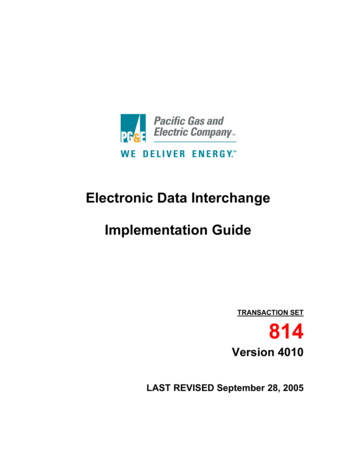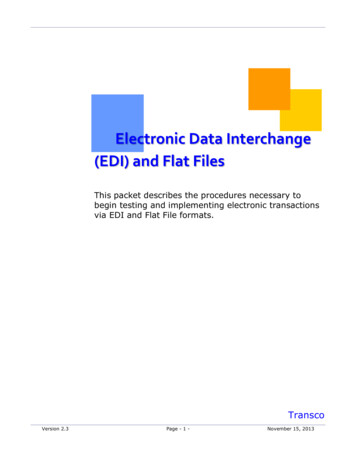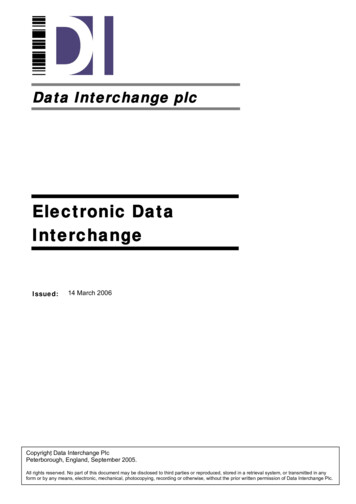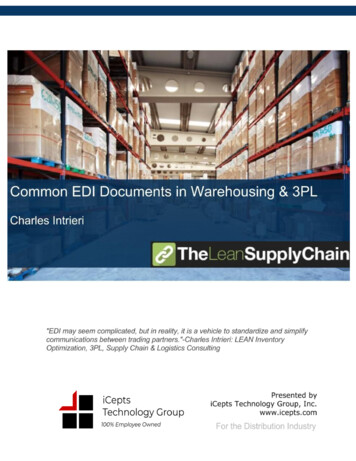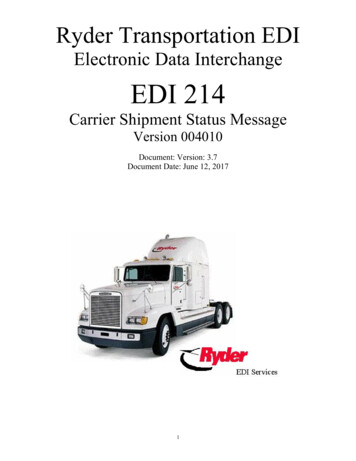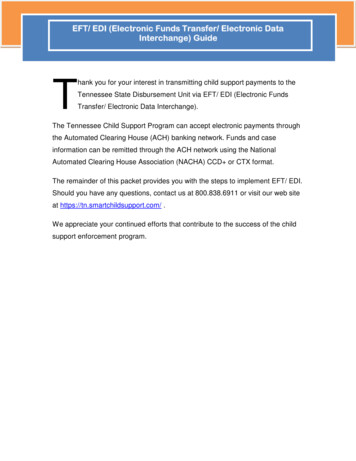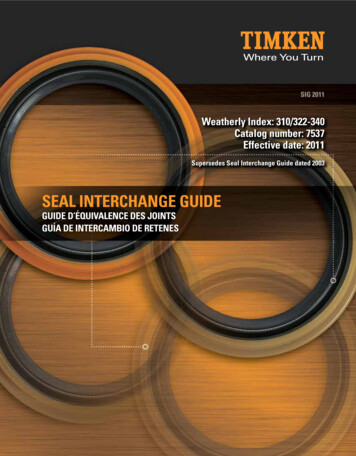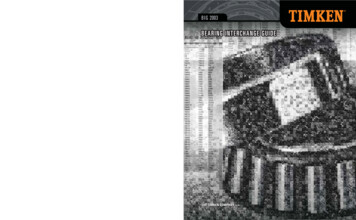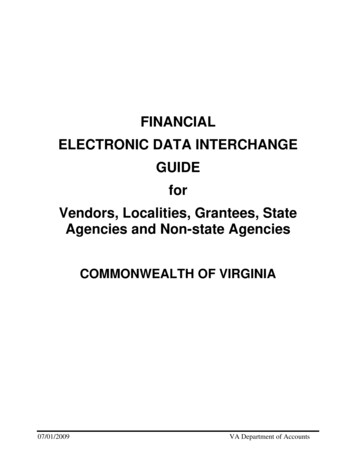
Transcription
FINANCIALELECTRONIC DATA INTERCHANGEGUIDEforVendors, Localities, Grantees, StateAgencies and Non-state AgenciesCOMMONWEALTH OF VIRGINIA07/01/2009VA Department of Accounts
Financial Electronic Data Interchange GuideTABLE OF CONTENTSWhat is Financial EDI? . 1Benefits To You, Our Trading Partner . 1How Do Payments and Remittance Data Get There? . 2Who Pays the Costs? . 2How Financial EDI Works for a Vendor . 3Remittance Data Passing Through the Banking System (CTX format) . 3Remittance Data by Way of the Internet (CCD payment format) . 5How Financial EDI Works for Localities, Grantees, Non-state and State Agencies . 7Remittance Data Passing Through the Banking System (CTX payment format) . 7Remittance Data by Way of the Internet (CCD payment format) . 9Get Ready . 11Get Set . 12Go . 12Financial EDI Made Easy . 13Remittance Data Made Easy . 14Remittance Data on the REDI Virginia Website . 14Remittance Data in the Electronic File Made Easy . 15Examples: Interpreting Remittance Data in the 820 Transaction Set . 16A payment from one agency with no credit transactions or adjustments . 16A payment from two agencies with no credit transactions or adjustments . 17A payment from one agency with a credit transaction, but no adjustments . 18A payment from one agency with an adjustment transaction to withholdmoney for a debt owed to the Commonwealth, but no credit transactions . 1907/01/2009VA Department of Accounts
Financial Electronic Data Interchange GuideTABLE OF CONTENTS (continued)Enrollment Forms . 20Reporting Changes in Your Organization’s EDI Information . 20Sample EDI Payment Agreement Form for Vendors . 21Sample Electronic Payment Information Form for Vendors . 22Sample Trading Partner Notification of Change Form . 23Remittance Assistance . 24Department of Accounts Contact Information . 25Glossary . 2607/01/2009VA Department of Accounts
WHAT IS FINANCIAL EDI?The purpose of this guide is to provide your organization with facts about theCommonwealth of Virginia’s Financial Electronic Data Interchange (FEDI) program.FEDI was implemented in May 1994. Electronic Data Interchange (EDI) is thecomputer-to-computer exchange of information between two or more parties, knownas Trading Partners. FEDI allows for the electronic exchange of payment andremittance information between the Commonwealth and our Trading Partners.FEDI combines Electronic Funds Transfer (EFT) with EDI capabilities to electronicallytransmit payment and remittance data to your organization. EDI is a low costalternative to the traditional paper check method of payment. EDI electronicallytransfers funds from the Commonwealth’s bank account to your organization’sdesignated bank account. These electronic payments are processed through theAutomated Clearing House (ACH) banking network. EDI remittance information fromthe various state agencies of the Commonwealth is posted to the Department ofAccounts REDI Virginia website for all trading partners and is transmitted to thedesignated financial institution for trading partners electing the CTX payment format.The EDI process allows your organization to have access to the funds on the paymentdue date and access to the EDI remittance detail on the REDI Virginia website one dayprior to the date of deposit. When all costs are considered, ACH payments are lessexpensive than paper checks for both the Commonwealth and your organization.BENEFITS TO YOU, OUR TRADING PARTNER No deposit delays Prompt availability of funds Better cash management Opportunity to automate updating of accounts receivable Remittance information available on REDI Virginia website and emailnotification of impending EDI deposit one day prior to date of deposit No lost or stolen checks Fully traceable payments More cost effective than handling paper checks07/01/20091VA Department of Accounts
HOW DO PAYMENTS AND REMITTANCE DATAGET THERE?Transmitting and receiving payment and payment-related information electronically willsave both your organization and the Commonwealth of Virginia the administrative costof processing and receiving paper checks. The following pages illustrate the methodsfor receiving your funds and remittance data electronically. They are: the CCD payment format, using the Department of Accounts' REDI Virginiawebsite for remittance information the CTX payment format, using the Banking System. Remittance data is alsoavailable on the REDI Virginia website.Both the CCD and CTX payment formats transmit the funds to your financial institution.They also determine how the remittance detail for your payments is provided to yourorganization. CCD routes the remittance detail to the REDI Virginia website. CTXroutes the remittance detail to your financial institution. CTX trading partners can alsouse the REDI Virginia website to research EDI payments.WHO PAYS THE COSTS?The Commonwealth of Virginia is responsible for the following processing costs: origination of the payment, REDI Virginia website, and transmitting the remittance data to the bank.Your organization is responsible for fees: related to electronic payment processing charged by your bank.07/01/20092VA Department of Accounts
HOW FINANCIAL EDI WORKS FOR A VENDORRemittance Data Passing Through the Banking System(CTX payment format)StateAgencyDepartmentof Accounts213TradingPartner476ACH5Trading Partner’sBankState’s Bank07/01/20093VA Department of Accounts
HOW FINANCIAL EDI WORKS FOR A VENDORRemittance Data Passing Through the Banking System (CTX payment format)(Keyed to preceding chart.)1.STATE AGENCIES procure goods/services from a TRADING PARTNER (vendor).2.The TRADING PARTNER provides goods/services to one or more State Agencies andsubmits a bill or invoice to each STATE AGENCY.3.STATE AGENCIES certify payments to the Trading Partner by inputting paymentrequests with payment remittance information in the Commonwealth’s general ledgersystem, which is controlled by the DEPARTMENT OF ACCOUNTS.4.The DEPARTMENT OF ACCOUNTS processes the STATE AGENCY paymentrequests and transmits the payment and the remittance information to the STATE’sBANK. Remittance information is also posted to the REDI Virginia website.5.The STATE’s BANK passes the payment and remittance information to the TRADINGPARTNER's BANK via the Automated Clearing House (ACH).6.The TRADING PARTNER’s BANK credits the payment to the Trading Partner’sAccount by the opening of business on the payment due date that is supplied by theState Agency. As prearranged by the Trading Partner, the TRADING PARTNER’sBANK then notifies the TRADING PARTNER of the deposit and provides the remittanceinformation to the TRADING PARTNER. Your bank may be able to provide anelectronic file that can be translated for automated payment application of funds to yourinternal accounts receivable system.7.The TRADING PARTNER posts its accounts receivable from the payment andremittance information received from the bank or the remittance information obtainedfrom the REDI Virginia website.A trace number is uniquely assigned by DOA to each electronic transmission to aTrading Partner. This number, which begins with “T”, is used by the TRADINGPARTNER to identify and match the remittance information with the correspondingpayment.NOTE: Multiple payments with the same payment due date from one State Agency orfrom various State Agencies to a Trading Partner are combined into one EDIpayment, under one Trace Number. The sum of all payments made by theCommonwealth’s agencies via EDI to a Trading Partner on a given day will appearon that Trading Partner’s bank statement. The remittance information provided byyour Bank or from the REDI Virginia website should reflect the sum of the EDIpayments and each individual payment – State Agency by State Agency, Invoice byInvoice.07/01/20094VA Department of Accounts
HOW FINANCIAL EDI WORKS FOR A VENDORRemittance Data by Way of the Internet(CCD Payment Format)07/01/20095VA Department of Accounts
HOW FINANCIAL EDI WORKS FOR A VENDORRemittance Data by Way of the Internet(CCD Payment Format)(Keyed to preceding chart.)1.STATE AGENCIES procure goods/services from a TRADING PARTNER (vendor).2.The TRADING PARTNER provides goods/services to one or more State Agencies and submitsa bill or invoice to each STATE AGENCY.3.STATE AGENCIES certify payments to the Trading Partner by inputting payment requests withpayment remittance information in the Commonwealth’s general ledger system, which iscontrolled by the DEPARTMENT OF ACCOUNTS.4.The DEPARTMENT OF ACCOUNTS processes the State Agency payment requests andtransmits the payment WITHOUT the remittance information, to the STATE’s BANK.5.While the payment information is transmitted to the State’s Bank, the remittance information istransmitted to the Department of Accounts' REDI Virginia website. Remittance information onthe REDI Virginia website is usually available one business day prior to the payment beingdeposited in the TRADING PARTNER’s bank account.6.The STATE’s BANK passes the payment to the TRADING PARTNER's BANK via theAutomated Clearing House (ACH) banking network.7.The TRADING PARTNER’s BANK credits the payment to the Trading Partner's account by theopening of business on the payment due date that is supplied by the State Agency. Dependingon the arrangements your organization has made with your bank, the TRADING PARTNER’sBANK may notify the TRADING PARTNER of the deposit to their account.8.The TRADING PARTNER posts its accounts receivable from the remittance informationobtained from the REDI Virginia website.A trace number is uniquely assigned by DOA to each electronic transmission to a TradingPartner. This number, which begins with a “T”, is used by the TRADING PARTNER to identifyand match the remittance information with the corresponding payment.NOTE: Multiple payments with the same payment due date from one State Agency or fromvarious State Agencies to a Trading Partner are combined into one EDI payment underone Trace Number. The sum of all payments made by Commonwealth of Virginia agenciesvia EDI to a Trading Partner on a given day will appear on that Trading Partner’s bankstatement. The remittance information from REDI Virginia will reflect the sum of the EDIpayments and each individual payment - State Agency by State Agency, Invoice by Invoice.07/01/20096VA Department of Accounts
HOW FINANCIAL EDI WORKS FOR LOCALITIES,GRANTEES, NON-STATE AGENCIES ANDSTATE AGENCIESRemittance Data Passing Through the Banking System(CTX Payment Format)StateAgencyDepartmentof Accounts15TradingPartner24ACH3Trading Partner’sBankState’s Bank07/01/20097VA Department of Accounts
HOW FINANCIAL EDI WORKS FOR LOCALITIES, GRANTEES,NON-STATE AGENCIES and STATE AGENCIESRemittance Data Passing Through the Banking System(CTX Payment Format)(Keyed to preceding chart.)1.STATE AGENCIES certify payments to the Trading Partner by inputting paymentrequests with payment remittance information in the Commonwealth’s general ledgersystem, which is controlled by the DEPARTMENT OF ACCOUNTS.2.The DEPARTMENT OF ACCOUNTS processes the STATE AGENCY paymentrequest and transmits the payment and the remittance information to the STATE’sBANK. Remittance information is also posted to the REDI Virginia website.3.The STATE’s BANK passes the payment and remittance information to the TRADINGPARTNER’s BANK via the Automated Clearing House (ACH) network.4.The TRADING PARTNER’s BANK credits the payment to the Trading Partner’s accountby the opening of business on the payment due date that is supplied by the StateAgency. As prearranged by the Trading Partner, the TRADING PARTNER’s BANKthen notifies the TRADING PARTNER of the deposit and provides the remittanceinformation to the TRADING PARTNER. Your bank may be able to provide anelectronic file that can be translated for automated payment application of funds to yourinternal accounts receivable system. Trading Partners can also access remittanceinformation on the Department of Accounts' REDI Virginia website.5.The TRADING PARTNER applies the payment to its accounts receivable system basedon the payment and remittance information received from the TRADING PARTNER’sBANK or the remittance information on the REDI Virginia website.A trace number is uniquely assigned by DOA to each electronic transmission to aTrading Partner. This number, which begins with a “T”, is used by the TRADINGPARTNER to identify and match the remittance information with the correspondingpayment.NOTE: Multiple payments with the same payment due date from one State Agency orfrom various State Agencies to a Trading Partner are combined into one EDIpayment under one Trace Number. The sum of all payments made by Stateagencies via EDI to a Trading Partner on a given day will appear on that TradingPartner’s bank statement. The remittance information provided by your Bank or fromthe REDI Virginia website should reflect the sum of the EDI payments and eachindividual payment – State Agency by State Agency, Invoice by Invoice.07/01/20098VA Department of Accounts
HOW FINANCIAL EDI WORKS FOR LOCALITIES,GRANTEES, NON-STATE AGENCIES and STATEAGENCIESRemittance Data by Way of the Internet(CCD Payment Format)07/01/20099VA Department of Accounts
HOW FINANCIAL EDI WORKS FOR LOCALITIES, GRANTEES,NON-STATE AGENCIES and STATE AGENCIESRemittance Data by Way of the Internet(CCD Payment Format)(Keyed to preceding chart.)1. STATE AGENCIES certify payments to the Trading Partner by inputting payment requestswith payment remittance information in the Commonwealth’s general ledger system, whichis controlled by the DEPARTMENT OF ACCOUNTS.2. The DEPARTMENT OF ACCOUNTS processes the State Agency payment requests andtransmits the payment WITHOUT the remittance information, to the STATE’s BANK.3. While the payment information is transmitted to the State’s Bank, the remittance informationis transmitted to the Department of Accounts' REDI Virginia website. Remittanceinformation on the REDI Virginia website is usually available one business day prior to thepayment being deposited in the TRADING PARTNER’s bank account.4. The STATE’s BANK passes the payment to the TRADING PARTNER’s BANK via theAutomated Clearing House (ACH) network.5. The TRADING PARTNER 's BANK credits the payment to the Trading Partner’s bankaccount by the opening of business on the payment due date that is supplied by the StateAgency. Depending on the arrangements your organization has made with your bank, theTRADING PARTNER’s BANK may notify the TRADING PARTNER of the deposit to theiraccount.6. The TRADING PARTNER applies the payment to its accounts receivable system based onthe remittance information obtained from the REDI Virginia website.A trace number is uniquely assigned by DOA to each electronic transmission to a TradingPartner. This number, which begins with a “T”, is used by the TRADING PARTNER toidentify and match the remittance information with the corresponding payment.NOTE: Multiple payments with the same due date from one State Agency or fromvarious State Agencies to a Trading Partner are combined into one EDI paymentunder one Trace Number. The sum of all payments made by State agencies viaEDI to a Trading Partner on a given day will appear on that Trading Partner’s bankstatement. The remittance information from the REDI Virginia website will reflect thesum of the EDI payments and each individual payment – State Agency by StateAgency, Invoice by Invoice.07/01/200910VA Department of Accounts
GET READY Designate an individual as the primary EDI contact in your organization. Assign implementation roles and responsibilities among your accounts receivableand cash management staff. Obtain the appropriate EDI Payment Agreement and Electronic Payment Informationforms and this Financial Electronic Data Interchange Guide from DOA's website(http://www.doa.virginia.gov). http://www.doa.virginia.gov) to read and see a sample of the remittance data availableon the REDI Virginia website. Read this Financial Electronic Data Interchange Guide. Decide how EDI detail remittance information provided by the Commonwealth ofVirginia will be received and processed by your accounts receivable and cashmanagement staff.o REDI Virginia website, using the CCD or CTX payment formatso Banking System, using the CTX payment format If CTX is selected, contact your bank to find out their capabilities, options, andcharges (if any) for translating and relaying electronic data to your organization. All banksand savings and loan institutions have the capability and are required to receive paymentsin all ACH formats. However, not all banks are EDI capable and able to translateelectronic data into a human readable format that can be readily used by their customersfor payment application. Therefore, various methods are used by banks to providecustomers their remittance information. Prior to enrolling in the Commonwealth’s EDIprogram, your organization should verify the method used by your bank to provide thedeposit and remittance information, i.e., on-line query, magnetic tape, telephone call,paper notification, bank statement, etc. Determine whether your bank can provide theremittance detail your organization must receive in order to post payments from stateagencies. The 820 Map (www.doa.virginia.gov) may be helpful to your organization’s andbank's personnel when discussing what remittance data the bank can relay to yourorganization. If a decision is made to receive remittance detail via your bank, it isrecommended that your organization contract with your bank for these services prior toenrolling in the EDI program.NOTE: If your organization is already utilizing the services of a Value Added Network (VAN),your funds can be deposited in your bank account, and your organization’s remittance datacan be sent in an electronic file format to the VAN specified. Identify the appropriate person(s) at your bank who can assist your organization withreceiving EDI payments through the ACH network.07/01/200911VA Department of Accounts
GET SET Complete the appropriate EDI Payment Agreement Form (for Vendors, Localities,Grantees, State Agenci
WHAT IS FINANCIAL EDI? The purpose of this guide is to provide your organization with facts about the Commonwealth of Virginia’s Financial Electronic Data Interchange (FEDI) program. FEDI was implemented in May 1994. Electroni
